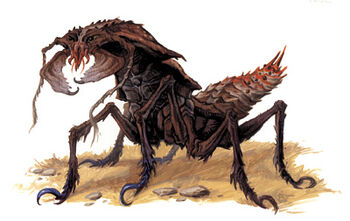Ankheg Broodling
An ankheg resembles an enormous many-legged insect, its long antennae twitching in response to any movement around it. Its legs end in sharp hooks adapted for burrowing and grasping its prey, and its powerful mandibles can snap a small tree in half.
Lurkers in the Earth. The ankheg uses its powerful mandibles to dig winding tunnels deep beneath the ground. When it hunts, an ankheg burrows upward, waiting below the surface until its antennae detect movement from above. Then it bursts from the earth and. seizes prey in its mandibles, crushing and grinding while it secretes acidic digestive enzymes. These enzymes help dissolve a victim for easy swallowing, but the ankheg can also squirt acid to take down foes.
Bane of Field and Forest. Although ankhegs receive a certain portion of their nutrients from the soil through which they burrow, they must supplement their diet with fresh meat. Pastures teeming with grazing livestock and forests rife with game are an ankheg's prime hunting grounds. Ankhegs are thus the bane of farmers and rangers everywhere.
Earthen Tunnels. As it burrows through earth, the ankheg leaves a narrow, partially collapsed tunnel in its wake. In these tunnels, one might find the remnants of molted ankheg chitin, hatched ankheg eggs, or the grisly remains of ankheg victims, including coins or other treasures scattered during the creature's attack.
Ankheg Ecology
Ankhegs are autumnal breeders and a typical brood produces about 1d8 surviving hatchlings. Within a year the broodlings begin to resemble adults and begin to wander from the nest reaching maturity within the next year.
Ankhegs prefer mild to warm fields or forest. Farmers in these regions need to be ever watchful for signs of ankheg burrows lest they be harvested by these carnivorous monsters, for though the ankheg can survive on carrion, they much prefer live prey.
Brave adventurers sometimes go looking for these creatures as the ankhegs shells can be fashioned into a middle weight armor (AC 14). The digestive fluids of the ankheg are as potent as any regular acid.

Ankheg Broodling
medium monstrosity, unaligned
- Armor Class 14
- Hit Points 27 (3d8+3)
- Speed 30 ft., burrow 10 ft.
STR DEX CON INT WIS CHA 15 (+2) 11 (+0) 13 (+1) 1 (-5) 13 (+1) 6 (-2)
- Senses darkvision 60 ft., tremorsense 60 ft.,
passive Perception 11- Languages —
- Challenge 1 (200 XP)
Actions
Bite. Melee Weapon Attack: +4 to hit, reach 5 ft., one target. Hit: 10 (1d6 + 2) slashing damage plus 2 (1d4) acid damage. If the target is a Medium or smaller creature, it is grappled (escape DC 12). Until this grapple ends, the ankheg broodling can bite only the grappled creature and has advantage on attack rolls to do so.
Acid Spray (Recharge 6). The young ankheg spits acid in a line that is 30 ft. long and 5 ft. wide, provided that it has no creature grappled. Each creature in that line must make a DC 13 Dexterity saving throw, taking 5 (1d10) acid damage on a failed save, or half as much damage on a successful one.
and: The Bestiary https://www.bestiary.co
and: contributors at r/UnearthedArcana